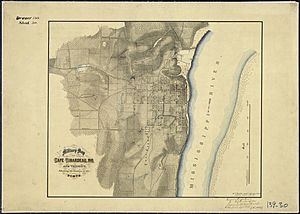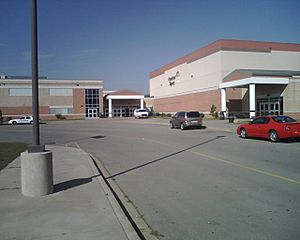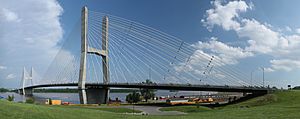Cape Girardeau, Missouri facts for kids
Quick facts for kids
Cape Girardeau, Missouri
|
|
|---|---|

Downtown Cape Girardeau
|
|
| Nicknames:
Cape, The City of Roses, River City
|
|
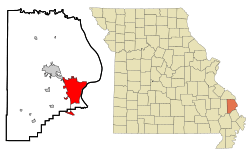
Location of Cape Girardeau in Cape Girardeau & Scott Counties, Missouri.
|
|
| Country | United States |
| State | Missouri |
| Counties | Cape Girardeau, Scott |
| Founded | 1793 |
| Government | |
| • Type | Council-Manager |
| Area | |
| • City | 29.31 sq mi (75.91 km2) |
| • Land | 29.25 sq mi (75.76 km2) |
| • Water | 0.06 sq mi (0.15 km2) |
| Elevation | 371 ft (113 m) |
| Population
(2020)
|
|
| • City | 39,540 |
| • Estimate
(2024)
|
40,589 |
| • Density | 1,351.75/sq mi (521.91/km2) |
| • Metro | 97,699 (US: 362nd |
| Demonym(s) | Cape Girardean |
| Time zone | UTC−6 (CST) |
| • Summer (DST) | UTC−5 (CDT) |
| ZIP Codes |
63701–63703, 63705
|
| Area code(s) | 573 |
| FIPS code | 29-11242 |
| GNIS feature ID | 2393737 |
Cape Girardeau (pronounced "jirr-AR-doh") is a city in Missouri, USA. It's located in Cape Girardeau and Scott Counties. In 2020, about 39,540 people lived there, making it one of Missouri's larger cities.
Cape Girardeau is an important economic hub for Southeast Missouri. It's also home to Southeast Missouri State University. The city is about 100 miles (160 km) southeast of St. Louis and 150 miles (240 km) north of Memphis.
Contents
History of Cape Girardeau
How Cape Girardeau Got Its Name
The city is named after Jean Baptiste de Girardot. He was a French soldier who set up a temporary trading post here around 1733. The "Cape" in the name referred to a rocky point overlooking the Mississippi River. This rock was later removed when railroads were built.
Early Settlements and Growth
The area became a settlement in 1793. The Spanish government, which owned Louisiana at the time, allowed a French-Canadian named Louis Lorimier to start a trading post. He gained special trading rights and a large area of land. Lorimier became the district's leader and grew wealthy from selling land and trading with local Native American groups.
Also in 1793, some Shawnee people, known as the Cape Girardeau Shawnee, were granted land near the city. They stayed in the area until 1833.
In 1799, American settlers opened the first English school west of the Mississippi River in Cape Girardeau. It was at a place they called Mount Tabor.
The town of Cape Girardeau officially became a town in 1808. It became a city in 1843. When steamboats started arriving in 1835, river trade boomed. This made Cape Girardeau a very busy port on the Mississippi River. It was the biggest port between St. Louis, Missouri and Memphis, Tennessee.
Civil War and Modern Times
During the Civil War, Cape Girardeau was the site of a small battle on April 26, 1863. Union and Confederate armies fought for about four hours. Both sides had only a few casualties.
For many years, people had to use ferries to cross the Mississippi River from Cape Girardeau. In 1928, a bridge was finished, connecting Missouri and Illinois. It was 20 feet (6.1 m) wide, which was standard for cars back then.
On May 21, 1949, a large tornado hit the city. It sadly killed 22 people and injured many more. Temporary shelters were set up in local schools and halls.
In December 2003, a new, modern four-lane cable-stayed bridge opened. It crosses the Mississippi River at Cape Girardeau. This bridge is named after former U.S. Representative Bill Emerson. Its two towers are about 300 feet (91 m) tall. The old bridge was taken down after the new one opened.
In 2008, Cape Girardeau was recognized as a "Preserve America Community." This was for its efforts to protect historic buildings.
The city is sometimes called "The City of Roses." This is because a 9-mile (14 km) stretch of highway used to be lined with many rose bushes. It's also known as "Cape Girardeau: Where the River Turns a Thousand Tales," celebrating its long history with the Mississippi River.
Historic Landmarks to Explore
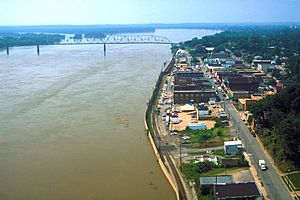
Cape Girardeau has many murals that show its history. The biggest one is the Mississippi River Tales Mural. It's on the downtown floodwall and covers almost 18,000 square feet (1,672 m2). It has 24 panels showing different stories. Behind the floodwall is the Riverfront Park of Cape Girardeau Missouri. Here, riverboats dock, and visitors can see the Mississippi River up close.
There are 39 historic places in Cape Girardeau listed on the National Register of Historic Places. These include eight historic districts. Some other important landmarks are the Fort D Historic Site and the Confederate War Memorial.
Geography of Cape Girardeau
Cape Girardeau covers about 28.49 square miles (73.79 km2). Most of this is land, with a small amount of water. The original "cape" that the city was named after no longer exists. However, a rock from that cape can still be seen in Cape Rock Park. It overlooks the Mississippi River.
Climate in Cape Girardeau
Cape Girardeau has a humid subtropical climate. This means it has four clear seasons. Winters bring a mix of rain, sleet, and snow. Sometimes there's heavy snowfall or ice. The average temperature in January is about 34.6°F (1.4°C). Summers are usually hot and humid. The average temperature in July is about 79.3°F (26.3°C). The city gets about 47.91 inches (1,217 mm) of rain each year, with spring being the wettest season.
| Climate data for Cape Girardeau Regional Airport, Missouri (1991–2020 normals, extremes 1960–present) | |||||||||||||
|---|---|---|---|---|---|---|---|---|---|---|---|---|---|
| Month | Jan | Feb | Mar | Apr | May | Jun | Jul | Aug | Sep | Oct | Nov | Dec | Year |
| Record high °F (°C) | 73 (23) |
79 (26) |
84 (29) |
91 (33) |
97 (36) |
107 (42) |
106 (41) |
105 (41) |
100 (38) |
94 (34) |
84 (29) |
76 (24) |
107 (42) |
| Mean maximum °F (°C) | 64.1 (17.8) |
68.5 (20.3) |
76.0 (24.4) |
83.2 (28.4) |
89.6 (32.0) |
95.4 (35.2) |
96.9 (36.1) |
96.1 (35.6) |
92.6 (33.7) |
86.2 (30.1) |
84.6 (29.2) |
65.1 (18.4) |
96.9 (36.1) |
| Mean daily maximum °F (°C) | 43.0 (6.1) |
48.2 (9.0) |
58.1 (14.5) |
69.0 (20.6) |
78.1 (25.6) |
86.6 (30.3) |
89.2 (31.8) |
88.3 (31.3) |
81.8 (27.7) |
70.9 (21.6) |
56.8 (13.8) |
46.3 (7.9) |
68.0 (20.0) |
| Daily mean °F (°C) | 34.6 (1.4) |
38.9 (3.8) |
47.7 (8.7) |
57.9 (14.4) |
67.8 (19.9) |
76.2 (24.6) |
79.3 (26.3) |
77.4 (25.2) |
69.7 (20.9) |
58.6 (14.8) |
46.7 (8.2) |
38.0 (3.3) |
57.7 (14.3) |
| Mean daily minimum °F (°C) | 26.2 (−3.2) |
29.7 (−1.3) |
37.3 (2.9) |
46.8 (8.2) |
57.5 (14.2) |
65.9 (18.8) |
69.3 (20.7) |
66.4 (19.1) |
57.7 (14.3) |
46.3 (7.9) |
36.7 (2.6) |
29.8 (−1.2) |
47.5 (8.6) |
| Mean minimum °F (°C) | 6.6 (−14.1) |
10.2 (−12.1) |
17.9 (−7.8) |
30.2 (−1.0) |
42.1 (5.6) |
53.3 (11.8) |
58.8 (14.9) |
54.3 (12.4) |
41.6 (5.3) |
29.1 (−1.6) |
20.5 (−6.4) |
10.9 (−11.7) |
6.6 (−14.1) |
| Record low °F (°C) | −18 (−28) |
−14 (−26) |
−8 (−22) |
18 (−8) |
30 (−1) |
43 (6) |
49 (9) |
45 (7) |
33 (1) |
22 (−6) |
8 (−13) |
−11 (−24) |
−18 (−28) |
| Average precipitation inches (mm) | 3.51 (89) |
3.31 (84) |
4.69 (119) |
5.18 (132) |
5.27 (134) |
3.80 (97) |
3.87 (98) |
3.23 (82) |
3.61 (92) |
3.57 (91) |
4.25 (108) |
3.62 (92) |
47.91 (1,218) |
| Average snowfall inches (cm) | 3.7 (9.4) |
4.4 (11) |
1.2 (3.0) |
0.0 (0.0) |
0.0 (0.0) |
0.0 (0.0) |
0.0 (0.0) |
0.0 (0.0) |
0.0 (0.0) |
0.2 (0.51) |
0.1 (0.25) |
1.8 (4.6) |
11.4 (28.76) |
| Average precipitation days (≥ 0.01 in) | 9.0 | 8.9 | 11.6 | 11.0 | 12.4 | 10.1 | 9.5 | 8.2 | 7.6 | 8.6 | 9.6 | 9.4 | 115.9 |
| Average snowy days (≥ 0.1 in) | 2.5 | 2.4 | 1.2 | 0.0 | 0.0 | 0.0 | 0.0 | 0.0 | 0.0 | 0.1 | 0.3 | 1.4 | 7.9 |
| Source: NOAA (snow 1981–2010) | |||||||||||||
People of Cape Girardeau
| Historical population | |||
|---|---|---|---|
| Census | Pop. | %± | |
| 1860 | 2,663 | — | |
| 1870 | 3,585 | 34.6% | |
| 1880 | 3,889 | 8.5% | |
| 1890 | 4,297 | 10.5% | |
| 1900 | 4,815 | 12.1% | |
| 1910 | 8,475 | 76.0% | |
| 1920 | 10,252 | 21.0% | |
| 1930 | 16,227 | 58.3% | |
| 1940 | 19,426 | 19.7% | |
| 1950 | 21,578 | 11.1% | |
| 1960 | 24,947 | 15.6% | |
| 1970 | 31,282 | 25.4% | |
| 1980 | 34,361 | 9.8% | |
| 1990 | 34,438 | 0.2% | |
| 2000 | 35,349 | 2.6% | |
| 2010 | 37,941 | 7.3% | |
| 2020 | 39,540 | 4.2% | |
| 2024 (est.) | 40,589 | 7.0% | |
| U.S. Decennial Census 2020 Census |
|||
Population and Diversity
In 2020, Cape Girardeau had a population of 39,540 people. There were about 15,855 households. The city is home to a diverse group of people. About 74.6% of the population was white, and 14.5% was black or African-American. About 2.6% were Asian, and 1.6% were from other races. People of Hispanic or Latino background made up about 3.1% of the population.
The average age in the city was 34.4 years old. About 18.3% of the population was under 18.
Economy of Cape Girardeau
Cape Girardeau has a strong economy. More than 100 businesses in the city employ at least 100 workers. Here are some of the top employers:
| # | Employer | # of Employees |
|---|---|---|
| 1 | St. Francis Medical Center | 3,143 |
| 2 | Mercy Hospital Southeast | 2,950 |
| 3 | Procter & Gamble | 1,200 |
| 4 | Southeast Missouri State University | 1,107 |
| 5 | Cape Girardeau Public Schools | 713 |
| 6 | Drury Hotels | 582 |
| 7 | Jackson R-II School District | 479 |
| 8 | Robinson Construction | 475 |
| 9 | Century Casino | 450 |
| 10 | Mondi | 428 |
Education in Cape Girardeau
Cape Girardeau has over 20 schools, from pre-kindergarten to colleges. The city has both public and private schools.
Public Schools
Most of Cape Girardeau is served by the Cape Girardeau Public Schools.
- Alma Schrader Elementary
- Blanchard Elementary
- Clippard Elementary
- Franklin Elementary
- Jefferson Elementary
- Central Middle School
- Central Junior High School
- Central Senior High School
- Career and Technology Center
- Alternative Education Center
Some parts of the city are in the Jackson R-II School District or the Scott City R-I School District.
Private Schools
- Notre Dame High School
- Trinity Lutheran School
- Eagle Ridge Christian School
- Prodigy Leadership Academy
- St Mark Lutheran Preschool
- St. Mary's Cathedral School
- St. Vincent De Paul Grade School
- Lynwood Christian Academy
Colleges and Universities
- Cape Girardeau Partnership for Higher Education
- Metro Business College
- Southeast Missouri State University
- Southeast Hospital College of Nursing & Health Sciences
- Eclipse School-Cosmetology
- Trend Setters-Cosmetology Inc
Public Library
The city has one public library: the Municipal Library District of the City of Cape Girardeau.
Media in Cape Girardeau
The main newspaper in Cape Girardeau is The Southeast Missourian.
Transportation in Cape Girardeau
Cape Girardeau has a special fund from sales tax to improve transportation. This money helps keep the city's streets in good condition.
The Cape Girardeau County Transportation Commission helps provide transportation for citizens.
Getting Around the City
In 2011, Cape Girardeau started the "Ride the City" program. This added 16 miles (26 km) of bicycle lanes on city streets. Some lanes are just for bikes, while others are shared with cars.
Public Transit
The Cape Transit Authority offers bus services throughout the city. A general ticket costs $2. Senior citizens pay $1, and children aged 6 and under ride for free. Special pick-ups can be arranged for people with disabilities. Greyhound buses are also available for longer trips.
Air Travel
The City of Cape Girardeau owns the Cape Girardeau Regional Airport. This airport offers flights to and from Nashville International Airport in Nashville, Tennessee.
Notable People from Cape Girardeau
-
Dale Dye
(born 1944)
Actor and retired U.S. Marine -
Linda M. Godwin
(born 1952)
Scientist and former NASA astronaut -
Rush Limbaugh
(1951–2021)
Radio personality and political commentator
- Jacob M. Appel, novelist
- Leon Brinkopf (1926–1998), baseball player
- Joseph Cable, a Medal of Honor recipient
- Shirley Crites (1934–1990), baseball player
- A.J. Ellis, former Major League Baseball catcher
- John Thomson Faris (1871–1949), clergyman
- Mary M. Hagan-Harrell, served in the Missouri House of Representatives
- Andrew Conway Ivy, (1893–1978), president of the American Physiological Society
- Peter Kinder, former Lieutenant Governor of Missouri
- Richard Kinder, businessman
- The Limbaugh family, including political commentators David and Rush Limbaugh
- Mark Littell, Major League Baseball pitcher
- James Naile (born 1993), Major League Baseball pitcher
- Roger Mosby (born 1951), former Chief Scout Executive of the Boy Scouts of America
- Stephanie O'Sullivan, Principal Deputy Director of National Intelligence
- Susan Beth Scott (born 1992), U.S. Paralympic Medalist Swimmer
- John Locke Scripps (1818–1866), journalist and biographer
- Tony Spinner, guitarist and singer
- Jeffrey Alexander Sterling, American lawyer and former CIA employee
- Billy Swan, singer
- Terry Teachout, writer
- Elam Vangilder, Major League Baseball pitcher
- Robert Henry Whitelaw (1854–1937), U.S. Congressman
See also
 In Spanish: Cape Girardeau (Misuri) para niños
In Spanish: Cape Girardeau (Misuri) para niños




